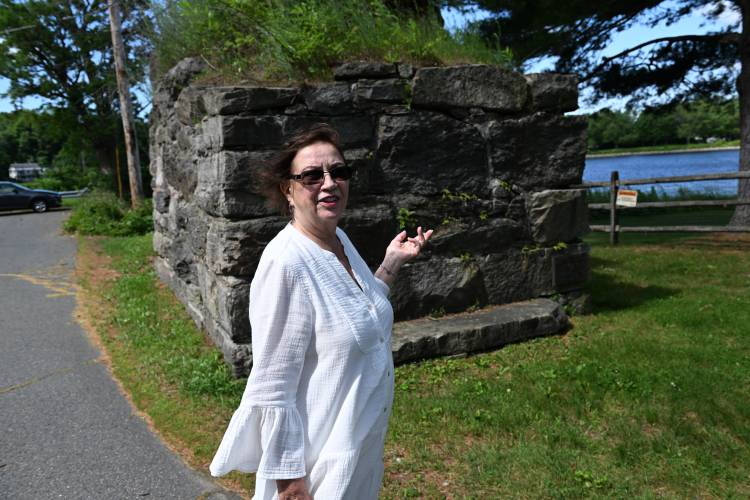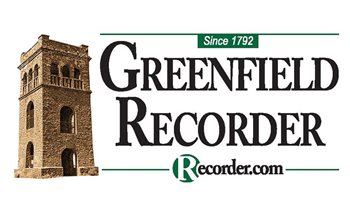40 years later, Gill resident recalls effort to preserve Red Bridge featuring Jurassic armored mud balls
|
Published: 06-27-2025 5:04 PM
Modified: 06-27-2025 7:52 PM |
GILL — Forty years ago this month, Gill resident Terri Rice remembers when the silence of anticipation broke inside Gill Town Hall.
It was June 18, 1985, and residents in attendance at Town Meeting had been asked to weigh in on whether to tear down the old Red Bridge cable anchorage on what was Bridge Street at the time and is Riverview Drive today.
After weeks of letter writing by local, state and national individuals and organizations who were interested in preserving the anchorage, as well as local outreach to residents about its significance in Franklin County’s history, the decision was ultimately in the hands of Rice’s neighbors.
“I heard the [vote count] of 85 to 25, and there was just a roar of the people,” Rice recalled, referencing when the results from the secret ballot vote were read, and the article that would’ve torn down the anchorage failed.
Gill’s former Red Bridge — a 563-foot-long suspension bridge that in 1878 connected Gill and Turners Falls across the Connecticut River — sat just outside Rice’s home on what is modern-day Riverview Drive, and the cable anchorage was going to be torn down by the town for being an obstruction to drivers.
As an educator at the time and someone who is passionate about history, two major historical elements of the bridge anchorage stood out to Rice, which encouraged her to have it preserved.
First, the quarried rock used for the anchorage contains two rare sedimentary structures called Jurassic armored mud balls, which were formed roughly 200 million years ago. These structures, consisting of dark, lithified shale surrounded by pebbles, formed after chunks of sticky mud eroded and rolled into a streambed, picking up pebbles before being covered by stream deposits. The mud balls in the Red Bridge cable anchorage were discovered by Greenfield Community College Professor Emeritus Richard Little in 1970, and Little worked with Rice in the effort to preserve the structure to protect the mud balls.
In addition to the mud balls within this anchorage, through her research on the Red Bridge, Rice obtained documents regarding its construction, including the specifications from the New York Bridge Co., which built the Red Bridge in accordance with designs crafted by John A. Roebling’s sons and using wire cables supplied by Roebling. This bridge predated the Brooklyn Bridge that opened in 1883, and it cost $41,741 to build, which is equivalent to roughly $1.3 million today.
Article continues after...
Yesterday's Most Read Articles
 Greenfield resident wanted by FBI for illicit marijuana operation
Greenfield resident wanted by FBI for illicit marijuana operation
 After ‘Herculean’ effort, Bridge of Flowers reopens in Shelburne Falls
After ‘Herculean’ effort, Bridge of Flowers reopens in Shelburne Falls
 A comforting craft: Greenfield knitting circle donates to hospital, police and school
A comforting craft: Greenfield knitting circle donates to hospital, police and school
 Greenfield Truck & Equipment to open on Beacon Street
Greenfield Truck & Equipment to open on Beacon Street
 ‘Lots to celebrate in the village’: Visitors rejoice over Bridge of Flowers opening
‘Lots to celebrate in the village’: Visitors rejoice over Bridge of Flowers opening
 Greenfield Fire Lt. Taylor retires after 33 years
Greenfield Fire Lt. Taylor retires after 33 years
Rice said she presented these letters and documents to the Selectboard prior to the June 18, 1985 meeting, with help from Northampton civil engineer Robert Curran, who also researched the bridge. This continued outreach on the history of the bridge led to Rice being featured in television news segments and national print publications like The Boston Globe, USA Today and the Associated Press.
This attention culminated in letters to Rice, including one from the Brooklyn Museum dated June 12, 1985, which states that, given the ties to Roebling’s major bridges, like the Brooklyn and Cincinnati bridges, “It would be a dreadful and foolish act to destroy the anchorage,” Associate Curator Barbara Head Millstein wrote. “Now it is the time for the town of Gill and its selectmen to stand up and be counted on the side of American engineering history.”
To sell her case before the scheduled Special Town Meeting on June 18, 1985, Rice and Little presented documents and letters to neighbors about the structure’s significance.
“I just thought it would educate the people to what we’ve got,” Rice said.
This history behind the Red Bridge was unknown to the Smithsonian Institute at the time, and Curator Robert Vogel visited the anchorage to photograph and study it for the institute in July 1985.
Documentarian and filmmaker Ken Burns reached out to Rice as well, expressing his support for her effort.
“Your old bridge might seem to some an anachronism, in the way, but most I’m sure will come around to the fact that to abandon the things we have built is to abandon ourselves,” Burns wrote. “Good luck.”
Rice hosted a block party and fundraiser through the Bridge Street Anchorage Preservation Society in October 1985, with funds used to commission a mural of the Red Bridge by artist Jeanie Schermesser based on a 1904 postcard of the bridge. The mural was then placed into a kiosk built by Gill resident Tony Matthews in 1995.
The anchorage would be given a Massachusetts Historic Engineering Landmark designation by the American Society of Civil Engineers’ Boston division in August 1990. To celebrate the occasion, a bronze plaque on the anchorage was installed on May 10, 1991.
Now, 40 years since she and hundreds of residents and officials gathered at Gill Town Hall on that hot summer evening, Rice is grateful for the support for this anchorage.
“I’m grateful that I researched, and went out to people … and I’m glad that I did, because people are learning from it, and it’s making more history now because of what it does entail,” she said. “A week doesn’t go by that somebody doesn’t stop that knows about it, and will stop and ask me different things if I’m home, and ask me to pinpoint things, or will slow down when they’re driving and see the mural and look at it, then realize what that anchorage is.”
Little, whose research on Jurassic armored mud balls has continued since his discovery more than 50 years ago, said that without Rice, an important piece of history would be gone forever.
“What Terri did is huge, because if the town had gone ahead to straighten the road, we would’ve lost out,” he said.
To continue to recognize the Jurassic armored mud balls, Little is seeking to have it designated as the state sedimentary structure. On Saturday, June 28, at 2 p.m., Little will be at the Great Falls Discovery Center in Turners Falls to mark the unveiling of mud balls that are being placed in the Discovery Center’s courtyard. He will be giving a multimedia presentation on the mud balls and he hopes to garner more support for his legislative effort seeking state designation.
Erin-Leigh Hoffman can be reached at ehoffman@recorder.com or 413-930-4231.











 PHOTOS: Avenue A upgrade underway in Turners Falls
PHOTOS: Avenue A upgrade underway in Turners Falls Sunderland office building latest to be considered for South County Senior Center home
Sunderland office building latest to be considered for South County Senior Center home
